Battle of Worcester artefacts unearthed for first time
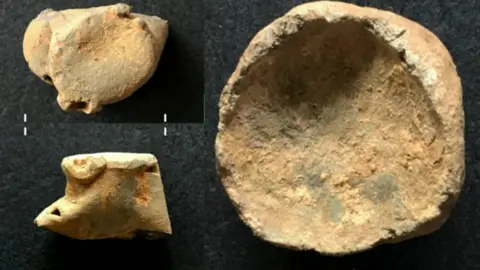 BBC
BBCArtefacts from the site of the final battle of the English Civil War have been unearthed for the first time.
Musket balls, horse harness fittings and belt buckles were found at the Battle of Worcester site in Powick, Worcestershire.
Historians have always known the area was the site of the 1651 battle, but it is the first time physical evidence has been recovered.
The artefacts will now be analysed and recorded.
Archaeologists were able to explore an area of land close to Powick Church while the Worcester Southern Link Road is being built.
They had hoped to find artefacts as there is shot damage on the church tower, while Powick Bridge was reportedly the location of intense fighting.
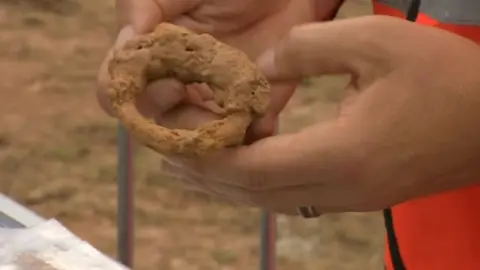 Getty Images
Getty Images
The 98 finds were buried deep at the bottom of a river valley and covered by flood deposits accumulated over hundreds of years since the battle.
They included a powder container cap, which would have been the top of a flask that held gunpowder, and an impacted lead shot - a lead ball fired from a musket.
The finds show the battlefield site was further south than previously thought.
Archaeologists said different artefacts were found in different areas of the battlefield, reflecting the different types of troops that would have been fighting.
For example, more pistol shots were found in one area, reflecting cavalry, while musket shots were found in another area, reflecting infantry.

The Battle of Worcester
- The English Civil War lasted from 1642 to 1651. Although usually called the English Civil War, it was a much wider conflict also involving Scotland, Ireland and Wales
- The Battle of Worcester took place in September 1651
- It was the final battle of the English Civil War
- Charles II escaped after his Royalist forces were defeated by Oliver Cromwell and the Parliamentarians
- He sought refuge at Boscobel House, in Shropshire, where he hid in a nearby oak tree to avoid capture when he was defeated

Richard Bradley, on-site lead archaeologist, said it was "fantastic" to be able to locate and map physical remains of the battle.
"We are just outside the registered battlefield area but this is still a nationally significant site," Mr Bradley said.
"The construction work has given us the opportunity to investigate the floodplain across which thousands of infantry and cavalry engaged, and to get down to the level where artefacts were deposited.
"Many of the lead musket and pistol balls show evidence of firing or impact and these tangible signs of the conflict offer a poignant connection to the soldiers who fought and died here."
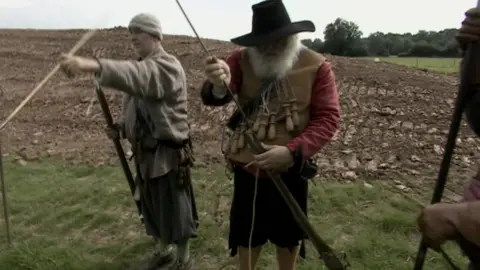
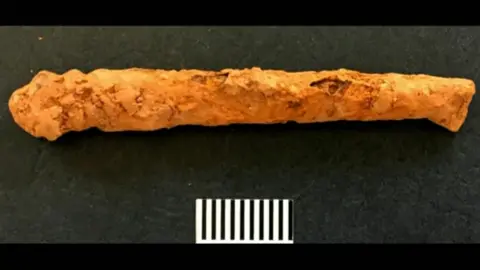 Worcestershire County Council
Worcestershire County CouncilArchaeologists were supported in their work by the construction teams, using their engineering equipment which was already on site.
Richard Shaw, chairman of the Battle of Worcester Society, said: "How exciting that 368 years after the Battle of Worcester these artefacts should be discovered.
"We are sure that there was fighting at this location on 3rd September 1651.
"Parliamentary forces had crossed the river at Upton-upon-Severn and were driving the Royalists back towards Worcester. The discoveries really bring the events of that day to life."
You may also like:
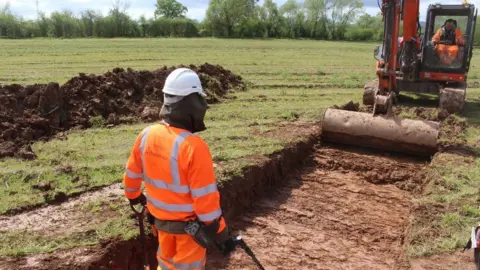 Worcestershire County Council
Worcestershire County Council
Your questions answered
We asked for your questions about this story and these are some of the things you wanted to know:
Were any contemporary coins found and, if so, what were they?
Coins from the 16th and 17th century were recovered, but none specifically of 1642-1651 date.
How do you know that the artefacts came from the 1651 Battle of Worcester and not the 1642 Battle of Powick Bridge?
Archaeologists at Worcestershire County Council say they can never be 100% certain, but accounts suggest the 1642 skirmish at Powick Bridge was a small cavalry engagement that took place in fields to the north of the bridge. As they are working further to the south, and the artefacts found closest to the bridge are from infantry weapons, then it is most likely they are from 1651.
How will the site and finds be preserved for future generations? Will there be further digs to uncover more of the remaining artefacts?
The project is ongoing and work will continue. At present it is a working construction site and the land is being heavily disturbed, which is why archaeologists are there. Once the project is complete, the finds could perhaps be deposited with Museums Worcestershire or with another local organisation, however this is yet to be decided and confirmed.

Follow BBC West Midlands on Facebook, on Twitter, and sign up for local news updates direct to your phone.
